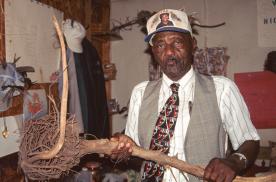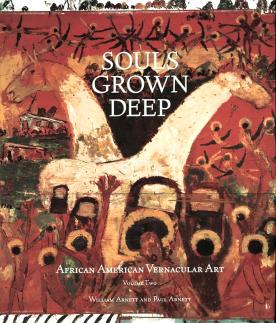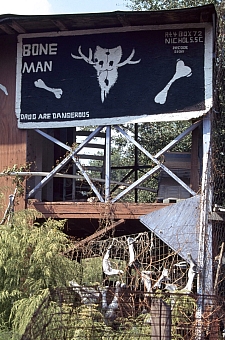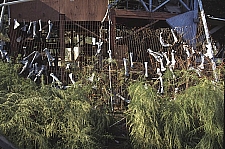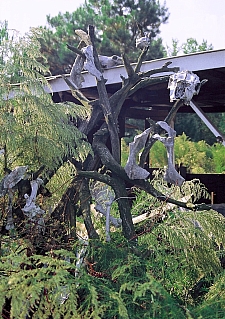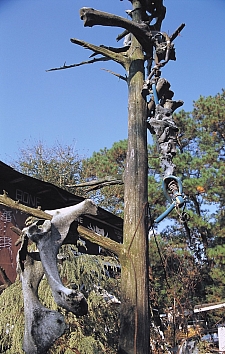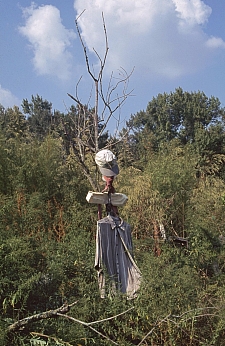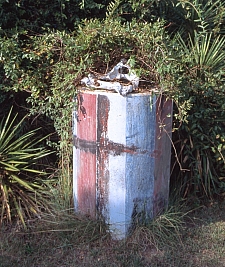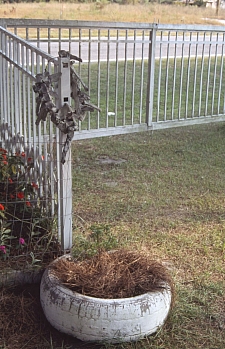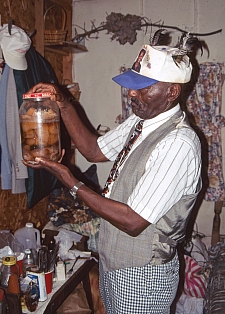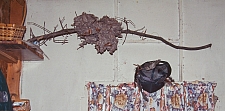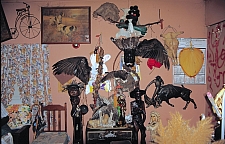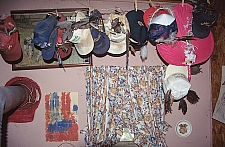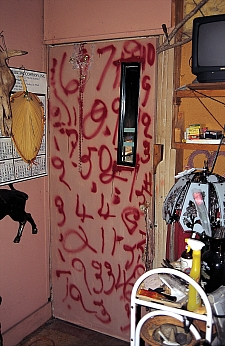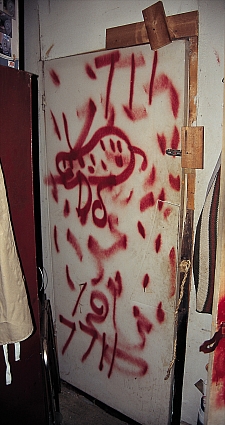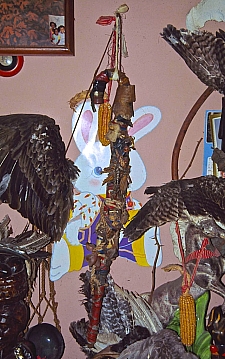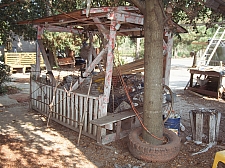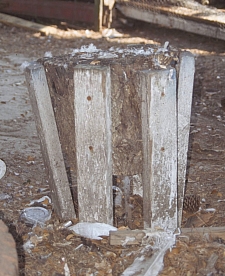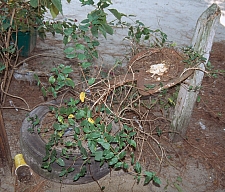Osker Gilchrist
About
Osker Gilchrist was a “little arm child” when his parents brought him to New York from Jamaica in 1925, the year of his birth. When he was three, they completed a long-planned pilgrimage by moving to a small house on a rural road outside Nichols, South Carolina, on a piece of land where Gilchrist’s great-grandfather once lived.
The Atlantic coast was only about forty miles away. There, the New World’s oldest permanent African American settlements had formed in the seventeenth century. Along that coast, many old African traditions have been preserved, as black populations on the barrier islands and in relatively isolated inland communities escaped many influences of mainstream American culture. Folk medicine is one of the oldest customs found among African Americans in the region. This traditional healing employs roots, herbs, and other plant life, as well as bones, charms, incantations, scripts, and, as with all types of medicine, a great deal of psychology.
Osker Gilchrist is a man of that medicine. People call him “Bone Man,” a nickname that does not displease him. In fact, he even advertises it on the facade of an unused outbuilding beside his house. He has long believed in his healing ability and powers of intuition and insight.
“I was born psychic. I always had the power When I was ten or twelve I realized I could cure people. When you got that talent, you got to study. So I studied with the people that could give me knowledge. Lot of my knowledge come from the dead. Come from dreams. I get dreams; they tell me stuff; they tell me when people was going to come see me. They tell me about stuff that’s going to happen."
He also knows how to recognize omens and act upon their implications. Everywhere he goes he looks for signs, messages in nature, which forewarn him or guide him through or away from potential danger. There are also messengers that inform him when he is needed. “If I’m going somewhere, if I’m away from here, and someone is back there wanting my services, I’ll see a certain bird, or snake, or spider, that let me know, and I turn around and come home.”
Gilchrist’s demeanor is that of the typical country general practitioner—wise, confident, and dignified—celebrated in American lore. The old house he grew up in is now his “office.” The first room of the two-sectioned house has become an elaborately decorated waiting room. One wall displays an assembly of carefully placed objects, each with symbolic or metaphysical significance. Among them are a hornets' nest, several well-preserved feathered wings from birds of prey, wood carvings from the Caribbean and the Far East, animal bones, aluminum foil, some flea-market pieces of household decor (e.g., a wall-hanging of a bullfighter and sculptures of a horse and a Native American), cloth scraps, a cow skull, calendars, and the magnum opus, “The Cane.”
"The Cane" is a major component of Gilchrist’s paraphernalia. From the wood staff hang charmlike adornments relating to conjuring and healing: bones, a raccoon’s foot, chains, artificial flowers, rope, a segment of a mule’s hoof, and more. According to Gilchrist, the cane belonged to his great-great-grandfather and passed through each generation until Gilchrist’s father gave it to him. The cane’s magic works on illnesses of the mind, but the cane is not so much an active healing device as it is a reminder of the durability of the traditions that invest Gilchrist with his power.
Gilchrist explicates his wall grouping: "The stuff represents different things. It represents trouble, trouble you get into. It helps you get shed of the trouble. The things there, they work with something you carry, something like the feets of birds, or ducks, or rabbits, or coons, or chickens, and they got to be wrapped up in the foil."
Also in the same area is a line of baseball-type caps hanging by clothespins from a wire stretched the width of the room. Feathers and other attachments adorn each cap. The combination of a cap’s color, its type of feathers, and its particular attachments imbues it with a specific power and ascribes to it a specific role in Gilchrist’s healing and conjuring process. Elsewhere in the room are other trappings of the trade: a lamp (from New York) that goes on and off at the touch of a sensor; a few small, abstract paintings on paper, the purposes of which are not disclosed; white wood doors covered with a personal kind of writing in red another hornets’ nest; and some family photographs, calming and reassuring.
In the second room, where Gilchrist treats his patients, he has lined his walls and shelves with power objects. Several hornets' nests are immediately visible. Regarding these, Gilchrist says, “We preserve those things for healing, and they can cure anything.” On top of a cabinet sits a complicated root growth that Gilchrist removed from a grave: “That root had grew around the head of a dead man. It was an old grave. It fell in. I took the head out of the root, and I use the root back here where I work.”
Scriptlike markings in red spray paint cover the doors in the backroom. The symbols and numbers (seven and eleven, for example) are about "good luck and power." The initials "D. S." on one door belong to "someone I knew," he says, unwilling to elaborate. A drawing of a hornet is included on another door as an indication of "the power to control the bee." There are also more feathered caps, and jars and containers filled with herbs, fungi, and roots, and lucky charms . . . and more roots. Roots and branches have "the power to cure whatever ills you, if you know what to do with them."
Gilchrist recounts some of his successes. "I work on mental and physical diseases, all of it. I have healed people with cancer and leukemia and gangrene. A doctor told someone she would be dead in a few days, and she come here, and been alive it’s been a few years now."
His patients need not believe in his healing powers. “I’ve got faith. They don’t need to have it. That’s what I’m for.”
Not as a complaint, but merely as an observation, Gilchrist says, ”People call me a hoodoo man or other bad stuff. Or talk bad talk about healers. But nine times out of ten, when they get sick or are dying, it’s ‘Oh Lord, help me, Lord Jesus! I believe!’ They start to repent and pray. And they come to me, too.”
They come from far away. Some, he says, have traveled a thousand miles for a consultation. One day a middle-aged woman showed up with her teenage son. They were from “the other side of Florence, South Carolina, about fifty miles.” The woman’s mother, an ardent devotee of Gilchrist’s, had often brought her as a child to see the Bone Man. Now the woman’s son was having academic difficulties and discipline problems at school. Gilchrist took the boy to his treatment area and closed the door. Now and then Gilchrist would come out to the waiting room, pick an ingredient for a potion or a charm, and return to his patient. After about fifteen minutes, the boy came out and departed with his mother. Both seemed satisfied.
“My power work on any kind of problem somebody have, Gilchrist says. “I can deal with it. I understand it. People come here for not only healing reasons, they need advice, and for information, and for my opinion. They come here even for lottery numbers.”
Partially concealed among the trees, vines, and weeds that surround Gilchrist’s "office" are outbuildings, sculptural assemblages, healing devices, and combinations of objects far beyond the subject matter of most yard decoration. For example, a shed—at first glance unremarkable, similar to those seen throughout rural areas for the storage of farm implements—is here covered with the red glyphlike symbols found throughout the interior of Gilchrist’s house. This shed contains a rack of elk antlers; a variety of working light fixtures, including a Christmas-tree decoration of an angel in a wreath surrounded by blinking lights; bones of all sizes; and inverted cups on posts (much like constructions found in rural African American cemeteries throughout the South). There are also metal grills, grates, and grids, and bed backs with symbolic designs reminiscent of Kongo cosmograms of Central Africa and the so-called hex signs of Europe and the New World. Attached to a tree, looking down from above the shed, is a doll’s head, surreal and mystifying.
Next to the shed, seven white-painted two-by-fours form the legs of a stool-like or altar-like tree stump covered with white chicken feathers. The stump is what it appears to be: a chopping block for the sacrifice of chickens, other fowl, and small animals. Traditional lore of the region holds that a white chicken should be split open and placed around the head of a person suffering from certain ailments. Gilchrist acknowledges the tradition, but says, "I don’t talk about my healing treatments." The ritual use of the white chicken is perhaps a retention of a Kongo funerary practice, documented to have survived along the Georgia-South Carolina coast, in which the chicken’s sacrifice releases powers of the "white realm" where the dead ancestors reside.
Across from the shed, near the front door to Gilchrist’s office, is an assemblage comprising an automobile tire, a metal tractor seat, and a wooden post. In the tractor seat lays a complete crab shell. The presence of such a shell probably descends from the placing of seashells on graves, another Kongo-related funerary tradition found along the Georgia-South Carolina coast and elsewhere. The shell houses the deceased’s immortal soul, and in an obvious reference to water, represents the ancestors’ watery abode. The entire work is littered with trash and grown with vines, encouraging casual observers to overlook it. When pressed, Gilchrist admits that it is part of his "equipment" and that the trash around it "disguises it and protects it."
His sculpture seems easy enough to interpret. It appears to be a commemorative monument to a dead farmer, or perhaps it is an actual grave marker. The most compelling reason for that conclusion is that Gilchrist has brought every component from elsewhere. One of the oldest African American funerary traditions is the adornment of graves with objects belonging to the deceased, especially the last objects used in life. A farmer who died on his tractor may lie beneath this marker. Or a close friend or relative whose power can assist Gilchrist and whose spirit can reside in the crab shell, next to the office. Could it be “D.S.,” the initials on the door nearby? Gilchrist smiles. then shrugs. Mystery is essential to the practice.
Other instruments for healing and protection are found throughout the yard. A Kleenex box is attached, along with a pair of rusty wire cutters, to the wall of another outbuilding. A necklace of old plowed-up bones hangs on a fence post near the two-lane highway that runs by the property. Further down the road, in front of the house where Gilchrist lives, rests an inverted metal drum, painted in alternating red, white and blue vertical panels, with crucifixes painted on opposite sides. The drum sits at the edge of a heavily wooded area. Vines have been manipulated to shroud the horse and cow bones arranged on top of the drum. It seems to say to those who pass by, I am a good Christian, and if you look closely you’ll see that I have additional interests.
Gilchrist says this: “I been doing with bones about fifty years. They got to be plowed up, dug up. All lands of bones, different bones for different stuff. I been making things out of bones on this property here for more than forty years. All them bones got a purpose for being there. All that junk got a purpose.”
In the field on the backside of the property stands an assortment of scarecrows. One is minimal—a white cloth garment draped over the branch of a small tree. One is an interesting little abstract sculpture composed of a piece of corrugated tin painted green, a segment of a metal post, and two white plastic bottles, all wired together. A shirt, a cap, a necktie, a slab of Styrofoam, and a plastic jug make up the third, more typical scarecrow. But there are no crops growing here. In fact, the field is overgrown with almost everything except crop plants. Crows wouldn’t be interested. So what do these scarecrows scare? (Artist Mary T. Smith used scarecrows similarly in her yard.)
“Well, they are used for something else, mostly on the healing side,” Gilchrist explains. The most elaborate scarecrow, in fact, has nothing to do with healing in the traditional sense, but is employed in another of Gilchrist’s repertoire of services. He is happy to explain, giving what amounts to an advertisement for this particular talent:
"If someone is searching to avenge, if you got somebody doing bad to you, you come to me. You got to give me the name of that person. I pick a hat from inside that represents your case. I switch it out with the hat on the scarecrow. When the full moon comes, I take that hat off of the scarecrow and wear it to the graveyard. I carry a special metal powder with me. I pow-wow around the grave and do what I have to do—I have a way to dance around, and I say what got to be said. My fee for doing it is $265.02. Exactly. It works. People can tell you."
If there is a focal point of Gilchrist’s grounds, it is a group of assemblages in the part of the yard where he keeps his animals (raccoons, rabbits, etc.) and fowl (chickens and ducks). There is a “bone rack,” a fence to which are tied perhaps a hundred animal bones, each, according to Gilchrist, chosen and placed for a specific reason. This rack, he says, “guards against all evil, everything bad that can happen, not just a one thing. I put it out there for general protection.” Near it is a bed frame, also draped with bones, which has a more specialized purpose for curing “people who suffer from nightmares and unpleasant dreams.” Also close by is an assemblage of driftwood like tree parts, arranged to simulate nature’s randomness. Attached to the assemblage are more bones, metal pans, and broken plastic and crockery jugs. A few feet away, a tall upright wood element is hung with bones, segments of garden hose, wire, metal tubing, and other materials, tied together, juxtaposed, and wrapped, forming a series of protective charms, This grouping—essentially the compound’s power center—provides not only “general protection” but also an advisory that potent powers are at work on this property. The assemblages are largely overgrown with plant life. Gilchrist does not bother to clean them up. This “bone man” in business beside the highway has attained a level of community acceptance that no longer requires much publicity or fear tactics.
After Gilchrist is gone, will anyone serve the region’s need for the type of services he provides?
“I have a son about fifteen years old,” Gilchrist says. “He has the power. I knew that he had it when I first looked at him. He is studying now, in New York. He will come back here. He will take over.”
All quotes by Osker Gilchrist are taken from interviews conducted by William Arnett in 1997.
